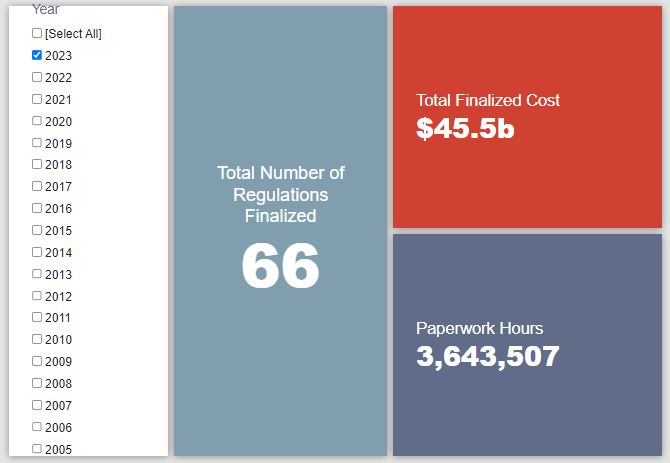Week in Regulation
May 22, 2023
Pipeline and Coal Ash Rules Make for Environment-Focused Week
Last week saw a pretty steady flow of action in the pages of the Federal Register. There were 14 rulemakings with some measurable economic impact and multiple actions crossing the billion-dollar threshold in terms of costs. A Department of Transportation (DOT) rule on pipeline safety and an Environmental Protection Agency (EPA) rule on “coal ash” represented the biggest-ticket items. Across all rulemakings, agencies published $17 billion in total costs and added 1.4 million annual paperwork burden hours.
REGULATORY TOPLINES
- Proposed Rules: 27
- Final Rules: 64
- 2023 Total Pages: 32,563
- 2023 Final Rule Costs: $45.5 billion
- 2023 Proposed Rule Costs: $302.2 billion
NOTABLE REGULATORY ACTIONS
The most consequential rulemaking of the week was the proposed rule from DOT regarding “Pipeline Safety: Gas Pipeline Leak Detection and Repair.” Specifically, the proposal seeks to make “a series of regulatory amendments to the Federal pipeline safety regulations … in response to a bipartisan congressional mandate in the Protecting our Infrastructure of Pipelines and Enhancing Safety Act of 2020 (PIPES Act of 2020, Pub. L. 116–260) and in support of the Biden-Harris Administration’s U.S. Methane Emissions Reduction Action Plan.” Some of the major changes include: updating the frequency and rigor of inspections for pipeline leaks, requiring operators to be more assertive in addressing leaks of gases such as methane, and setting up a more robust monitoring and reporting system. DOT estimates that rulemaking could involve annual costs to affected operators of roughly $827 million (the average of the low and high estimates given here), or $8.1 billion in present value.
The other notable action of the week came from EPA’s proposed rule on “Hazardous and Solid Waste Management System: Disposal of Coal Combustion Residuals [CCR] From Electric Utilities; Legacy CCR Surface Impoundments.” This action represents the latest episode in the legal travails for CCR regulations going back to a 2015 Obama-era rule on the matter and “is being proposed in response to the August 21, 2018, opinion by the U.S. Court of Appeals … that vacated and remanded the provision exempting legacy impoundments from the CCR regulations.” EPA estimates $413 million in annualized costs (or $4.8 billion in present value) due to “the costs of unit closure, corrective action, fugitive dust controls, structural integrity inspections, and recordkeeping and reporting.”
TRACKING THE ADMINISTRATIONS
As we have already seen from executive orders and memos, the Biden Administration will surely provide plenty of contrasts with the Trump Administration on the regulatory front. And while there is a general expectation that the current administration will seek to broadly restore Obama-esque regulatory actions, there will also be areas where it charts its own course. Since the AAF RegRodeo data extend back to 2005, it is possible to provide weekly updates on how the top-level trends of President Biden’s regulatory record track with those of his two most recent predecessors. The following table provides the cumulative totals of final rules containing some quantified economic impact from each administration through this point in their respective terms.
![]()
With last week’s most significant actions coming as proposed rules, there were only relatively modest shifts in the Biden to-date final rule totals. Costs and paperwork increased by $35 million and 348,000 hours, respectively. The administrative burdens from the Biden Administration’s latest immigration rule provided most of those increases. The Obama Administration saw remarkably similar increases during the middle of May 2011 with $49 million in new costs and 360,000 additional hours of paperwork. The Trump Administration, however, saw the most notable shift with a $1.6 billion decrease in costs, driven primarily by a deregulatory action concerning offshore oil and gas rigs.
THIS WEEK’S REGULATORY PICTURE
This week, another federal agency moves to keep flexibilities it developed during the height of the COVID-19 pandemic.
 Source: Photo by Malte Helmhold on Unsplash
Source: Photo by Malte Helmhold on Unsplash
For the second week in a row, a federal agency is looking to extend policies temporarily established during the COVID-19 pandemic that make it easier for people to communicate about important personal business matters. The prior week had to do with how patients and medical providers communicated remotely about certain prescriptions. This week’s example deals with the opportunity for individuals to more easily participate remotely in the adjudication of claims for disability insurance with the Social Security Administration (SSA).
As SSA notes: “In March 2020, we closed our offices to walk-in traffic, suspended in-person and VTC appearances, and began offering claimants an option to appear at hearings by telephone in response to the Coronavirus Disease 2019 (COVID–19) national public health emergency.” In light of the pandemic situation, the agency “allowed claimants to appear using: (1) private electronic devices (rather than our equipment or agency-approved equipment); and (2) third-party software designated by us, rather than the proprietary software approved for use on our equipment or agency-approved equipment.” The proposed rule seeks to extend this more expansive policy going forward.
The rule represents a shift from previous policy (which, until this rulemaking becomes final, is technically still on the books) that required individuals to participate “by video using our equipment or equipment that we [SSA] approve,” as opposed to the individuals’ own personal devices. As one can imagine, traveling to a location to utilize SSA-approved equipment is, for most, probably no more convenient than simply conducting the proceeding in-person at an SSA office. The agency conducted “65,000 hearings by online video and 900,000 hearings by telephone” through the end of 2022, and to likely the surprise of no one: “Since August 2021, the overall satisfaction score has been 4.2 [out of 5] or higher, and 83 percent or more of respondents in each month since then have reported an overall satisfaction rate of a 4 or 5.” SSA also expects this flexibility to enhance the agency’s casework flow since it will allow agents to schedule and conduct hearings in a more efficient manner.
Interested parties have until July 18, 2023, to submit comment.
TOTAL BURDENS
Since January 1, the federal government has published $347.7 billion in total net costs (with $45.5 billion in new costs from finalized rules) and 52.8 million hours of net annual paperwork burden increases (with 3.6 million hours in increases from final rules).











